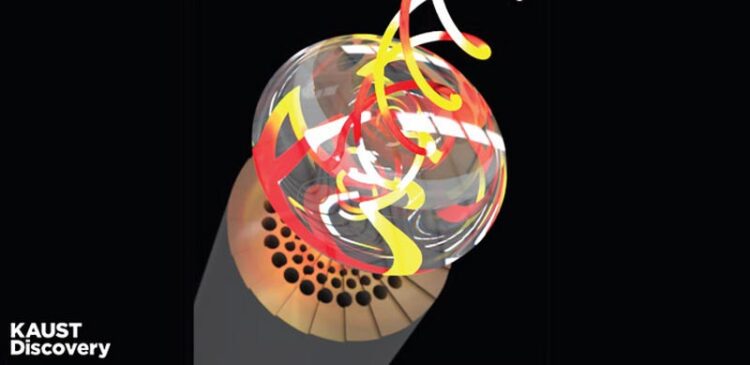Customized fiber generates Bessel beams

Illustration of the KAUST team's custom-engineered optical fiber, known as a Bessel beam, which they fabricated using a technique called two-photon lithography.
Credit: © 2022 KAUST; Andrea Bertoncini
An all fiber-based approach to generating special optical beams, called Bessel beams, could open up new applications in imaging, optical trapping and communications.
Bessel beams look quite different from the usual Gaussian light beams found in optics. In particular, they possess several interesting properties including self-healing, diffraction-free propagation and the ability to carry orbital angular momentum (OAM). This family of beams — also known as vortex beams with a characteristic ring-like shape and a dark central region — include different “orders” of beams carrying different values of OAM.
However, the creation of Bessel beams is somewhat inconvenient: several bulk optical elements, such as spatial light modulators or cone-shaped axicons, are needed to convert Gaussian beams to Bessel beams.
Now, Innem Reddy, Andrea Bertoncini and Carlo Liberale from KAUST have experimentally demonstrated that a custom-engineered optical fiber can do the job and generate a particular Bessel beam on demand.
“Generating Bessel beams using traditional techniques involves space-consuming, expensive optical elements that require precise alignment,” explains Reddy, a Ph.D. student in the group. “By opting for a fiber-based solution, we can obtain a compact Bessel beam generator that is pre-aligned and can deliver these beams even in remote and confined spaces, such as endoscopic applications.”
“In particular, the fiber-based generation of Bessel beams allows innovative applications, such as minimally invasive endoscopic probes, optical coherence tomography, fiber-based optical trapping and manipulation of microscopic particles.”
The team’s fiber is a masterpiece of custom engineering. They use a technique called two-photon lithography (TPL), which enables 3D printing of intricate optical structures to fabricate special beam-shaping elements directly onto the tip of a single-mode optical fiber. Their design has three segments that, collectively, efficiently align and transform a conventional Gaussian beam into an annular beam and then, finally, a Bessel beam of the desired order and OAM value.
The work is the latest triumph in a research program that intends to leverage the potential of the TPL technique, where light is used to “write” fine optical structures by solidifying a photoresist.
The team has already used TPL to customize fibers in other ways, including the creation of polarization beam splitters, microlens assemblies and optical tweezers. “Fabricating ever more sophisticated optical devices on the end of optical fibers to empower them to deliver complex functionalities is one of the main research directions of our group,” commented Liberale.
Journal: Optica
DOI: 10.1364/OPTICA.453839
Article Title: 3D-printed fiber-based zeroth- and high-order Bessel beam generator
Article Publication Date: 10-Jun-2022
All latest news from the category: Information Technology
Here you can find a summary of innovations in the fields of information and data processing and up-to-date developments on IT equipment and hardware.
This area covers topics such as IT services, IT architectures, IT management and telecommunications.
Newest articles

First-of-its-kind study uses remote sensing to monitor plastic debris in rivers and lakes
Remote sensing creates a cost-effective solution to monitoring plastic pollution. A first-of-its-kind study from researchers at the University of Minnesota Twin Cities shows how remote sensing can help monitor and…

Laser-based artificial neuron mimics nerve cell functions at lightning speed
With a processing speed a billion times faster than nature, chip-based laser neuron could help advance AI tasks such as pattern recognition and sequence prediction. Researchers have developed a laser-based…

Optimising the processing of plastic waste
Just one look in the yellow bin reveals a colourful jumble of different types of plastic. However, the purer and more uniform plastic waste is, the easier it is to…



